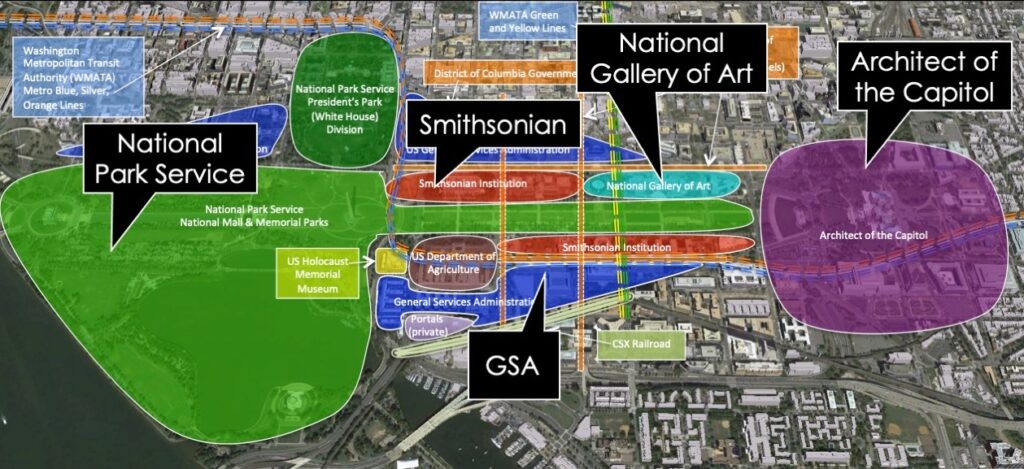Who decides what museums or monuments can be built on the National Mall, what public activities are allowed or forbidden? Why does every new project or development plan seem to get caught up in controversy?
The simple fact is that there is no unified, coordinated entity governing policy for the National Mall. Instead, as this diagram shows, at least eight agencies manage parts of the Mall. Many more DC and federal agencies have plan review authority, while in Congress 14 committees have oversight over Mall matters. The result is policies that are uncoordinated and even contradictory. The American public has no meaningful say in policy matters — but should.
What is needed is unified Mall governance — an entity such as New York City’s Central Park Conservancy — to bring together all constituencies, including the public, to provide unified policies and planning.
The problems of weak and uncoordinated policy-making are numerous. For example, Congress in 2003, concerned about overbuilding of memorials on the Mall (but lacking a long-range plan for the Mall in its 3rd century), declared the Mall a “substantially completed work of civic art” but already has made exceptions for a Vietnam Veterans Memorial visitors center, the Martin Luther King Jr. Memorial, and the National Museum of African American History and Culture. Clearly this “completed” policy is not working and the threat of overbuilding on the open space continues with no end in sight.
Another threat to the vitality of the Mall as public open space is that the various Mall managing agencies develop their own public use policies that sometimes are contradictory and ignore the importance of the Mall as the people’s place. For example, in recent years popular public events such as the Library of Congress’s National Book Festival and the Department of Energy’s Solar Decathlon have been denied permits by the National Park Service in order to protect the Park Service’s new turf grass. But why should protection of the grass trump cultural events? Mall policy should recognize that cultural events such as the Book Festival should be encouraged; they are the lifeblood of the Mall’s meaning.

Mall managing agencies cannot even agree on a definition of the Mall — what buildings are on it, what are the boundaries, what is its purpose? Click on the illustration at right and learn more on our Research page.
The lack of coherent public policy threatens the integrity of the historical Mall and the future vitality of this national treasure. The National Mall Coalition advocates formation of a new McMillan-type commission to look at the Mall holistically and coordinate policy matters. Ultimately, we need to create unified governance to ensure intelligent, coordinated policy making in the future: How do we define the Mall and understand its meaning in American democracy? Can the Mall ever be “complete” when American history continues to unfold and future generations will want their place on the Mall? How can we bring all Mall constituencies to the table to develop intelligent public policies that support the Mall’s enduring role in our country’s cultural and civic life?
Learn Mall history and read our concept for America’s 3rd Century Mall here.

